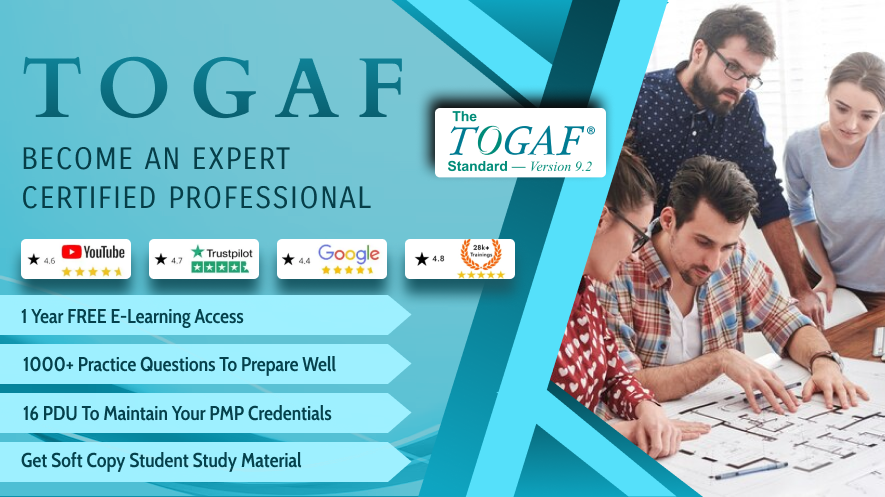
In the dynamic landscape of enterprise architecture, professionals are constantly seeking ways to enhance their skills and stay relevant in a rapidly evolving industry. The Open Group Architecture Framework, or TOGAF, has emerged as a leading methodology for creating and implementing enterprise architectures that drive business success. TOGAF training has become increasingly popular among professionals looking to advance their careers and make meaningful contributions to their organizations. In this comprehensive guide, we’ll explore everything you need to know about TOGAF training, including its importance, benefits, certification levels, training options, and tips for success.
Understanding TOGAF:
TOGAF, developed and maintained by The Open Group, provides a comprehensive approach to designing, planning, implementing, and governing enterprise architectures. It offers a structured framework that enables organizations to align their IT infrastructure and business processes with their strategic goals and objectives.
TOGAF is based on four key architectural domains:
- Business Architecture
- Data Architecture
- Application Architecture
- Technology Architecture
By addressing these domains, TOGAF helps organizations develop a holistic view of their enterprise architecture, fostering better decision-making, improved efficiency, and enhanced agility.
Importance of TOGAF Training:
TOGAF training plays a crucial role in equipping professionals with the knowledge, skills, and best practices needed to effectively apply the framework within their organizations. Here’s why TOGAF training is essential:
-
Industry Recognition: TOGAF is widely recognized and respected across industries, making TOGAF-certified professionals highly sought after by employers worldwide.
-
Standardization: TOGAF provides a standardized approach to enterprise architecture, ensuring consistency and coherence in architectural planning and implementation.
-
Enhanced Competence: Training in TOGAF enhances professionals’ competence in enterprise architecture, enabling them to develop robust architectures that align with business objectives and drive value.
-
Career Advancement: TOGAF certification enhances career prospects and opens up opportunities for advancement into roles such as Enterprise Architect, Solution Architect, and IT Director.
Benefits of TOGAF Training:
Investing in TOGAF training offers numerous benefits to both individuals and organizations:
-
Comprehensive Knowledge: TOGAF training provides a deep understanding of enterprise architecture concepts, principles, and best practices.
-
Improved Decision-Making: Certified TOGAF professionals are equipped to make informed decisions regarding architectural design, planning, and implementation.
-
Global Recognition: TOGAF certification is recognized and respected worldwide, enhancing professionals’ credibility and marketability.
-
Increased Efficiency: By following TOGAF methodologies, organizations can streamline their architectural processes, leading to improved efficiency and resource utilization.
-
Risk Mitigation: TOGAF promotes a systematic approach to risk management, helping organizations identify and address potential architectural issues before they escalate.
TOGAF Certification Levels:
TOGAF certification is available at two levels:
-
TOGAF Foundation (Level 1): The Foundation level focuses on understanding the basic concepts and terminology of TOGAF. It validates individuals’ knowledge of the core principles and concepts underlying the framework.
-
TOGAF Certified (Level 2): The Certified level delves deeper into the application of TOGAF principles and methodologies. It requires candidates to demonstrate their ability to analyze and apply TOGAF concepts in real-world scenarios.
Training Options:
TOGAF training is available through various channels, including:
-
Instructor-Led Training (ILT): Instructor-led courses are conducted by accredited training providers and offer interactive learning experiences with experienced instructors.
-
Online Training: Online TOGAF courses provide flexibility and convenience, allowing individuals to learn at their own pace and schedule.
-
Self-Study: Self-study options, such as textbooks and study guides, are available for individuals who prefer to learn independently and prepare for certification exams at their own pace.
Tips for Success:
To maximize the benefits of TOGAF training and certification, consider the following tips:
-
Set Clear Goals: Define your objectives for pursuing TOGAF certification and tailor your training accordingly.
-
Stay Committed: Dedicate time and effort to your TOGAF studies, maintaining consistency and focus throughout the training process.
-
Practice Regularly: Apply TOGAF concepts to real-world scenarios and projects to reinforce your understanding and build practical skills.
-
Engage with Peers: Participate in forums, study groups, and networking events to exchange ideas, seek advice, and stay updated on industry trends.
-
Stay Updated: Keep abreast of the latest developments in TOGAF and enterprise architecture to ensure your skills remain relevant and up-to-date.
Conclusion:
TOGAF training is a valuable investment for professionals seeking to excel in the field of enterprise architecture. By gaining a thorough understanding of TOGAF principles and methodologies, individuals can contribute to organizational success by designing and implementing robust architectures that drive business value. Whether you’re just starting your journey in enterprise architecture or looking to advance your career to the next level, TOGAF training provides the knowledge, skills, and credentials needed to succeed in today’s competitive landscape. Embrace the opportunities that TOGAF training offers, and position yourself as a trusted advisor and strategic partner in your organization’s architectural journey.






